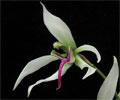|
|
|
|
 |
Email Address Recovery or Password Reset |
Use our Change Password page, and you can set a new password, or if you don't remember which email address you
registered with, the same page may be able to suggest it based on another you enter.
|
|
|
|
|
| |
Flasks of
Ancistrochilus thomsonianus 'MC5253' × self |
|
| |
|
|
| |
| Number: |
TN6779 |
| Name: |
Ancistrochilus thomsonianus 'MC5253' × self
|
| Type: |
self (What's that?) |
|
Click to Enlarge

Pod Parent Flower |
Click to Enlarge

Pod Parent Flowers |
|
|
|
| |
Culture Notes from Donor: Parent plant: Temperature range Intermediate 83-60°F, Cool-Intermediate 75-58°F in the cooler season. Easy to grow. Tolerates medium levels of all culture variables, i.e. light, water, temperature, humidity, air flow. Potted with sphagnum in plastic pot with a drainage layer.
Comments: Parent plant: An African epiphyte that grows on large branches. Deciduous. Small plant.
For additional origin/habitat information supplied courtesy of
Charles and Margaret Baker, see further below, near the bottom of this page.
|
Temperatures we attempt to use in the lab & greenhouse:
| For Species: |
|
Spring, Summer, Autumn, Winter: days average 77°F, nights 63°F; best fit is Intermediate 83-60°F
(Source:
Baker's Web OSC) |
|
About the name...
| Etymology of |
Ancistrochilus |
|
From latinized Greek "ankistron" hook; "cheilos" lip. From the lip which is bent like a hook.
(Source:
Mayr & Schmucker 1998) |
| Etymology of |
thomsonianus |
|
Named for Thomson, an English missionary in West Africa during the 19th century.
(Source:
Mayr & Schmucker 1998) |
| Pronunciation of |
Ancistrochilus |
|
an-sis-TRO-ki-lus
(Source:
Hawkes 1978) |
|
If you would like to direct someone to this web page, please copy and paste this URL into your email:
http://troymeyers.com/d?016779
| Flask Information |
| Availability: |
We have sold all of the flasks for this item. |
| You should: |
Consider getting individual plants or compots instead of a flask.
You can place a "Notify Flask Recipients" Request, and either we or a flask recipient may contact you when plants are available.
You may also place a "Notify Retries" Request, and if an identical pollination (the same parents) is done again, we'll let you know.
You may reserve a flask, but it's very unlikely you'll get one ...this could only happen if we found a flask that we didn't know we had. |
| Yield Estimate: |
1210 plants (based on flask surveys done 01/07/2010 through 10/05/2011)
|
| Plantlet Sizes: |
From many flasks 0.2 - 70 mm plants (based on flask surveys done 09/03/2009 through 05/29/2012)
From one most recently surveyed flask 30 - 55 mm (05/29/2012)
|
|
You might also want to:
|
View the seed assay for this item.
View items of the same species.
View items of the same genus.
|
| Ordering Information |
| You are not currently logged in. |
|
You must be a registered user and be logged in to reserve a flask or place a notification request. Please log in:
|
|
 |
Email Address Recovery or Password Reset |
Use our Change Password page, and you can set a new password, or if you don't remember which email address you
registered with, the same page may be able to suggest it based on another you enter.
|
|
|
|
|
|
|
|
| |
The origin/habitat information below is supplied courtesy of Charles and Margaret Baker
The following information is based on the name of the plant provided by the donor, and assumes that the name is correct. If the plant has been misidentified, then the following information may not be correct.
This text is copyrighted by the Bakers and may not be reproduced without permission.
ORIGIN/HABITAT: West Africa. Plants grow in forests in Cameroon and
Nigeria. Specific details of habitat elevation have not been reported, but
Hutchinson & Dalziel (1968) reported that plants have been found near
Calabar, Nigera, and La Croix & La Croix (1997) reported that these plants
grow in similar habitat to Ancistrochilus rothschildianus and should
thrive in the same conditions.
More about this information and the Bakers...
|
|
|
| |
|
|
|